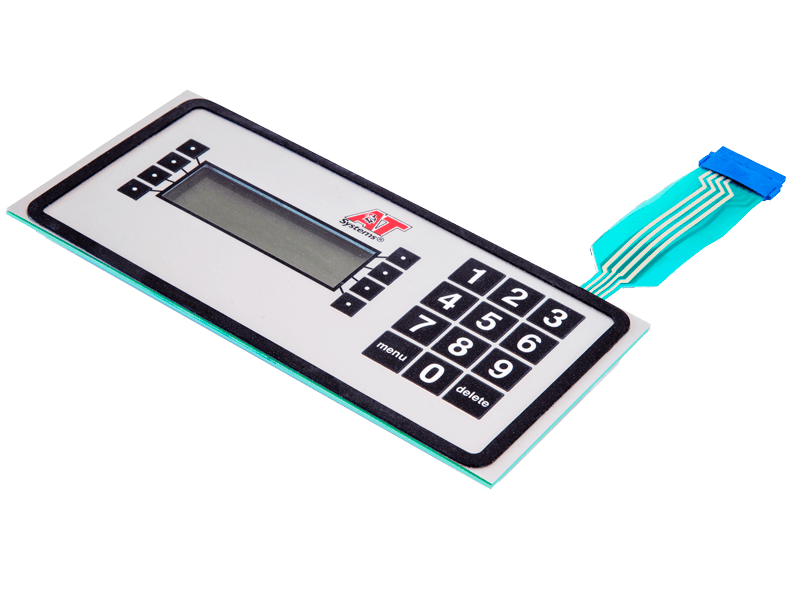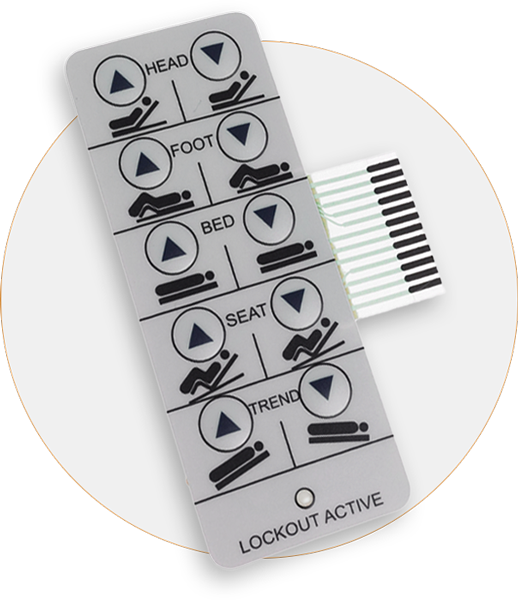All Regarding Membrane Change: Comprehending Its Design and Performance
When you assume concerning the control user interfaces in modern gadgets, membrane buttons commonly come to mind. Allow's explore what collections membrane layer switches apart from other control systems.
What Are Membrane Switches?

Their smooth nature makes them simple to clean and resistant to dust and moisture, an essential feature in numerous settings. Membrane layer buttons can additionally be tailored relating to shape, dimension, and graphics, enabling suppliers to produce one-of-a-kind interfaces tailored to certain items. And also, they're light-weight and slim, which assists in lessening the total bulk of gadgets. Overall, membrane layer buttons play a significant duty in improving customer experience across a wide range of applications.
Just How Membrane Layer Switches Over Work
When you press a secret on a membrane switch, it turns on a straightforward yet efficient mechanism. membrane switch manufacturer. The leading layer, frequently made of adaptable material, presses down onto a conductive layer below it.
You'll notice that the responsive feedback differs based upon the switch design, offering either a soft click or a more noticable feedback. As soon as you launch the key, the membrane go back to its original placement, reopening the circuit and quiting the signal. This process happens virtually instantaneously, making sure a responsive user experience.
Membrane layer switches are prominent as a result of their longevity and resistance to dust and dampness, making them excellent for different applications, from family home appliances to clinical gadgets. Comprehending this operation aids you appreciate their prevalent use.
Key Elements of Membrane Buttons
Understanding the vital parts of membrane layer switches is fundamental for understanding their performance and style. At the core, you'll find the visuals overlay, which supplies the aesthetic user interface for customers. Under that, there's a spacer layer that separates the circuit layers, making certain that they do not make contact till pushed. The circuit layer is where the magic occurs; it contains conductive traces that finish the circuit when you push the button. An additional crucial component is the sticky support, enabling the switch to adhere to surfaces safely. The safety layer guards versus ecological variables and wear, extending the button's life expectancy. Each part plays a significant function in guaranteeing trustworthy performance and user communication. By comprehending these components, you'll gain understanding right into exactly how membrane switches operate and their significance in numerous applications.
Materials Used in Membrane Layer Switch Over Design
The efficiency and durability of membrane changes greatly rely on the materials used in their style. You normally run into polyester and polycarbonate as main substratums as a result of their outstanding strength and adaptability. These products withstand scratches and chemicals, making them perfect for requiring environments.
The conductive layers often use silver or carbon, selected for their reliability and conductivity. membrane switch manufacturer. Silver gives exceptional performance, while carbon is an economical alternative. For the overlay, you could think about a matte or shiny finish, depending on your visual demands and user experience
Adhesives play a crucial role also; they bond layers safely and guarantee durability. Make sure to select adhesives that stand up to environmental factors like temperature and humidity. Do not neglect the value of an excellent printing technique for graphics, as it improves both capability and visual charm. Picking the ideal products will certainly guarantee your membrane layer button stands the examination of time.
Style Considerations for Membrane Layer Switches
While designing membrane switches, it's important to take into account different variables that influence their functionality and individual experience. Beginning by concentrating on the design and button size; make specific they're intuitive and very easy to browse.
Validate your style accommodates environmental variables, like dampness or temperature variants, which might influence efficiency. By meticulously thinking about these elements, you'll create a membrane switch that improves use and satisfaction.
Applications of Membrane Layer Switches
Membrane switches are functional parts found in different applications, from industrial equipment to consumer electronic devices. You'll see their impact in equipments that require long lasting user interfaces and in tools that gain from smooth designs. Recognizing these applications helps you appreciate the capability and practicality of membrane layer buttons in daily innovation.
Industrial Equipment Use
When you're looking to enhance the functionality of industrial equipment, membrane buttons use a dependable option that combines longevity with straightforward design. These buttons are best for severe settings, offering resistance to dirt, dampness, and chemicals. Accept membrane switches to improve your operations and improve general efficiency.
Consumer Electronic Devices Integration
In the domain name of customer electronics, membrane buttons play a crucial function in enhancing individual communication and device performance. Membrane layer switches additionally assure durability and resistance to dirt and dampness, expanding the life-span of your electronic devices. By selecting membrane layer switches, you improve not simply the performance yet likewise the style of your gadgets, making day-to-day communications smooth and satisfying.
Benefits and Drawbacks of Membrane Buttons
While membrane layer buttons supply a variety of benefits, they additionally come with some drawbacks that you should consider. One substantial benefit is their compact design, making them suitable for space-constrained applications. They're likewise cost-effective, giving a sturdy option with a low manufacturing price. Furthermore, their smooth surface area is easy click to tidy, improving hygiene in environments like hospitals.

Membrane switches can have a much shorter life expectancy compared to mechanical buttons, especially under hefty usage. They can likewise be much less responsive, which might influence individual comments during top article operation. Stabilizing these pros and cons will help you establish if membrane switches are the best fit for your job.
Regularly Asked Concerns
Exactly How Long Do Membrane Layer Changes Normally Last?
Membrane layer switches commonly last between 5 to ten years, depending on use and ecological problems. You'll desire to evaluate elements like wear, direct exposure to moisture, and temperature level variations to gauge their longevity successfully.
Can Membrane Layer Switches Be Customized for Particular Designs?
Yes, you can customize membrane buttons to fit details styles (membrane switch manufacturer). You'll have the flexibility to pick shades, shapes, and layouts that match your project's needs, ensuring they blend seamlessly with your total visual
What Is the Cost Range for Membrane Change Production?
The cost variety for membrane layer button production commonly falls between $1 and $10 per device, depending on variables like layout intricacy, quantity, and materials. You can obtain quotes from makers to locate the most effective option.

Are Membrane Changes Water Resistant or Resistant?
Membrane layer switches can be made to be water resistant or immune, depending on materials used and building methods. If you need them for wet atmospheres, assure you define those demands throughout the style click for more info process.
How Do Membrane Switches Contrast to Typical Switches?
Membrane switches are usually thinner and extra versatile than standard buttons, using a sleek layout. They're often easier to clean and integrate, however may not supply the tactile responses you're made use of to with mechanical alternatives.
Conclusion
